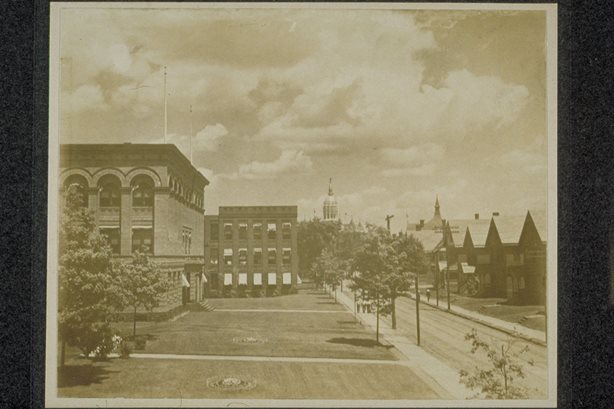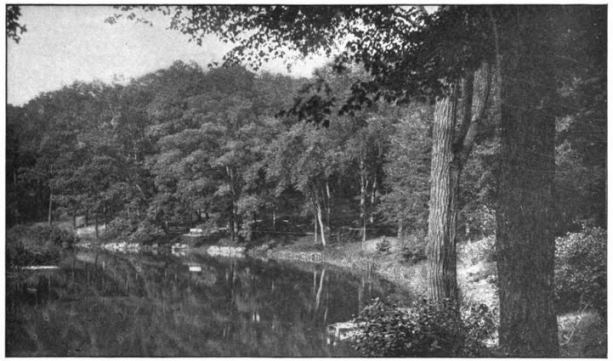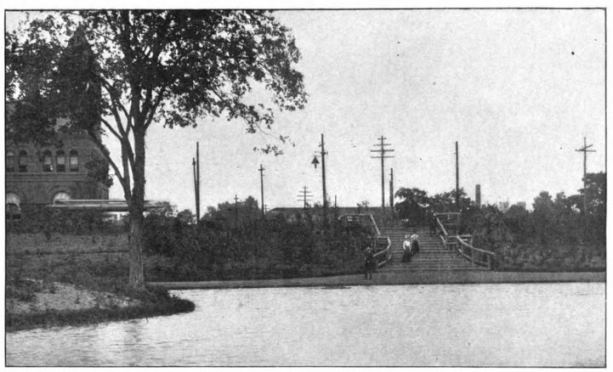I believe that a large part of the success of any manufacturing business depends upon the health, happiness, and orderly life of its employees, and that in a like manner a city thrives best by caring and providing for the well being of its citizens. – Albert Pope
In 1894, Colonel Albert Pope, of Columbia Bicycle and Pope Manufacturing fame, donated (what eventually grew to) 90.5 acres to the City of Hartford for a park. Pope originally purchased Bartholomew Farm close to his business complex to expand his factories and to create 1,200 homes for workers in planned villages. The economy and infrastructure complications undermined those efforts, however, and instead of building, he hired renowned landscape architects the Olmsted Brothers to design and landscape the former farm for his workers and city residents to enjoy.

Factories of the Pope Manufacturing Co., Hartford, 1905, 1988.137.12 – Connecticut Historical Society
The Olmsted brothers completed the park design in 1898 and, in its original form, it contained ponds, recreational open space, tennis courts, and outdoor gymnasiums. While Pope Park served its Frog Hollow neighborhood well at the end of the 19th century, it was not unique to Hartford at the time. In fact, the trend toward setting aside land for passive recreation was incredibly popular and Hartford embraced it. In a little over a year—from August 1894 to November 1895—five parks (Pope, Keney, Riverside, Elizabeth, and Goodwin) totaling approximately 1,200 acres were left in trust and established along the city’s periphery.
Frog Hollow
Before 1850 the area in which Pope Park resides (now known as “Frog Hollow”) was mainly farmland. It sat on the outskirts of Hartford’s downtown and contained both a river and a newly built railroad—a perfect place for burgeoning industry. Sharps Rifle Company was the first large manufacturer to come to the area, trailed by The Weed Sewing Machine Company; others soon followed. When Colonel Albert Pope moved in, his empire, which is said to have rivaled Samuel Colt’s from decades earlier, further transformed the neighborhood. His bicycle and automobile manufacturing business created hundreds of jobs which, in turn, created the need for more area housing. A building boom ensued and countless multi-family houses sprung up. Farmland disappeared and in its place came housing and streets, creating a 35-block neighborhood around the factory sites.

Illustration of the “Park River and Bankside Grove – Pope Park” from the book The Picturesque Parks of Hartford, 1909
One of the world’s largest bicycle manufacturers, Pope believed that success in business relied on the happiness of a company’s employees. Workers and their families craved respites from busy industrial life, and passive recreation and open space provided that. When Albert Pope created Pope Park, he intended it “for use by the citizens as a public park for all time without restriction.” Shortly after Pope donated the land to the city, PC Royce, secretary of the Hartford Fire Insurance Company, noted that “[Hartford] had not paid enough attention to the idea of making it a fit place to live in. This proposed park would be in that direction.”

Illustration “The Tennis Courts – Pope Park” from the book The Picturesque Parks of Hartford, 1909
Albert Pope’s Park in the 20th Century
In the first half of the 20th century, Pope Park was a place for residents to gather for celebrations and events. Thousands flocked to the park to witness fireworks displays and enjoy band music. On the 4th of July in 1935, a fireworks display even honored the state’s 300th birthday.
As the decades wore on, the city faced large-scale deindustrialization. Factories closed or moved away, leaving large building complexes abandoned and in disrepair. Workers moved away, seeking new opportunities. The Frog Hollow neighborhood’s popularity began to decline.
Some would argue that the neighborhood encompassing Pope Park today retains little of its past grandeur, but many Frog Hollow residents revere their neighborhood’s history and architecture. In 1979 the district was placed on the National Register of Historic Places, and at the turn of the 21st century, Friends of Pope Park, a local group that aims to preserve the park, helped to develop a master plan to revitalize it and ensure Pope Park serves Connecticut residents in much the same way it has for more than a century.









